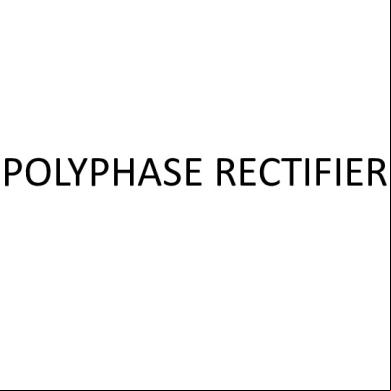Rectifier 3n4b6b
This document was ed by and they confirmed that they have the permission to share it. If you are author or own the copyright of this book, please report to us by using this report form. Report 3i3n4
Overview 26281t
& View Rectifier as PDF for free.
More details 6y5l6z
- Words: 292
- Pages: 18
RECTIFIERS
INTRODUCTION
A rectifier is
an
electrical
converts alternating periodically
reverses
device
current (AC), direction,
that which
to direct
current (DC), which is in only one direction, a process known as rectification.
TYPES OF RECTIFIERS Half wave Rectifier Full wave Rectifier Bridge Rectifier
HALF WAVE RECTIFIER
In half wave rectification, either the positive or negative half of the AC wave is ed, while the other half is blocked.
Because
only
one
half
of
the
input
waveform reaches the output, it is very inefficient if used for power transfer.
HALF WAVE RECTIFIER WORKING ANIMATION
HALF WAVE RECTIFICATION
OUTPUT DC VOLTAGE CALCULATION
The output DC voltage of a half wave rectifier can be calculated with the following two ideal equations
FULL WAVE RECTIFIER
A full-wave rectifier converts the whole of the input waveform to one of constant polarity (positive or negative) at its output.
Full-wave rectification converts both polarities of the input waveform to DC (direct current), and is more efficient.0
FULL WAVE RECTIFIER WORKING ANIMATION
FULL WAVE RECTIFICATION
In a circuit with a non - center tapped transformer, four diodes are required instead of the one needed for half-wave rectification.
For single-phase AC, if the transformer is centertapped, then two
diodes back-to-back
(i.e.
anodes-to-anode or cathode-to-cathode) can form a full-wave rectifier.
FULL WAVE RECTIFIER USING 4 DIODES
FULL WAVE RECTIFIER USING TRANSFORMER AND 2 DIODES
FORMULA
The average and root-mean-square output voltages of an ideal single phase full wave rectifier can be calculated as:
OUTPUT VOLTAGE OF THE FULL WAVE RECTIFIER ANIMATION
BRIDGE RECTIFIER
A bridge rectifier makes use of four diodes in a bridge arrangement to achieve full-wave rectification.
BRIDGE RECTIFIER CIRCUIT
BRIDGE RECTIFIER WORKING ANIMATION
THE END
…… Thank You ……
INTRODUCTION
A rectifier is
an
electrical
converts alternating periodically
reverses
device
current (AC), direction,
that which
to direct
current (DC), which is in only one direction, a process known as rectification.
TYPES OF RECTIFIERS Half wave Rectifier Full wave Rectifier Bridge Rectifier
HALF WAVE RECTIFIER
In half wave rectification, either the positive or negative half of the AC wave is ed, while the other half is blocked.
Because
only
one
half
of
the
input
waveform reaches the output, it is very inefficient if used for power transfer.
HALF WAVE RECTIFIER WORKING ANIMATION
HALF WAVE RECTIFICATION
OUTPUT DC VOLTAGE CALCULATION
The output DC voltage of a half wave rectifier can be calculated with the following two ideal equations
FULL WAVE RECTIFIER
A full-wave rectifier converts the whole of the input waveform to one of constant polarity (positive or negative) at its output.
Full-wave rectification converts both polarities of the input waveform to DC (direct current), and is more efficient.0
FULL WAVE RECTIFIER WORKING ANIMATION
FULL WAVE RECTIFICATION
In a circuit with a non - center tapped transformer, four diodes are required instead of the one needed for half-wave rectification.
For single-phase AC, if the transformer is centertapped, then two
diodes back-to-back
(i.e.
anodes-to-anode or cathode-to-cathode) can form a full-wave rectifier.
FULL WAVE RECTIFIER USING 4 DIODES
FULL WAVE RECTIFIER USING TRANSFORMER AND 2 DIODES
FORMULA
The average and root-mean-square output voltages of an ideal single phase full wave rectifier can be calculated as:
OUTPUT VOLTAGE OF THE FULL WAVE RECTIFIER ANIMATION
BRIDGE RECTIFIER
A bridge rectifier makes use of four diodes in a bridge arrangement to achieve full-wave rectification.
BRIDGE RECTIFIER CIRCUIT
BRIDGE RECTIFIER WORKING ANIMATION
THE END
…… Thank You ……










